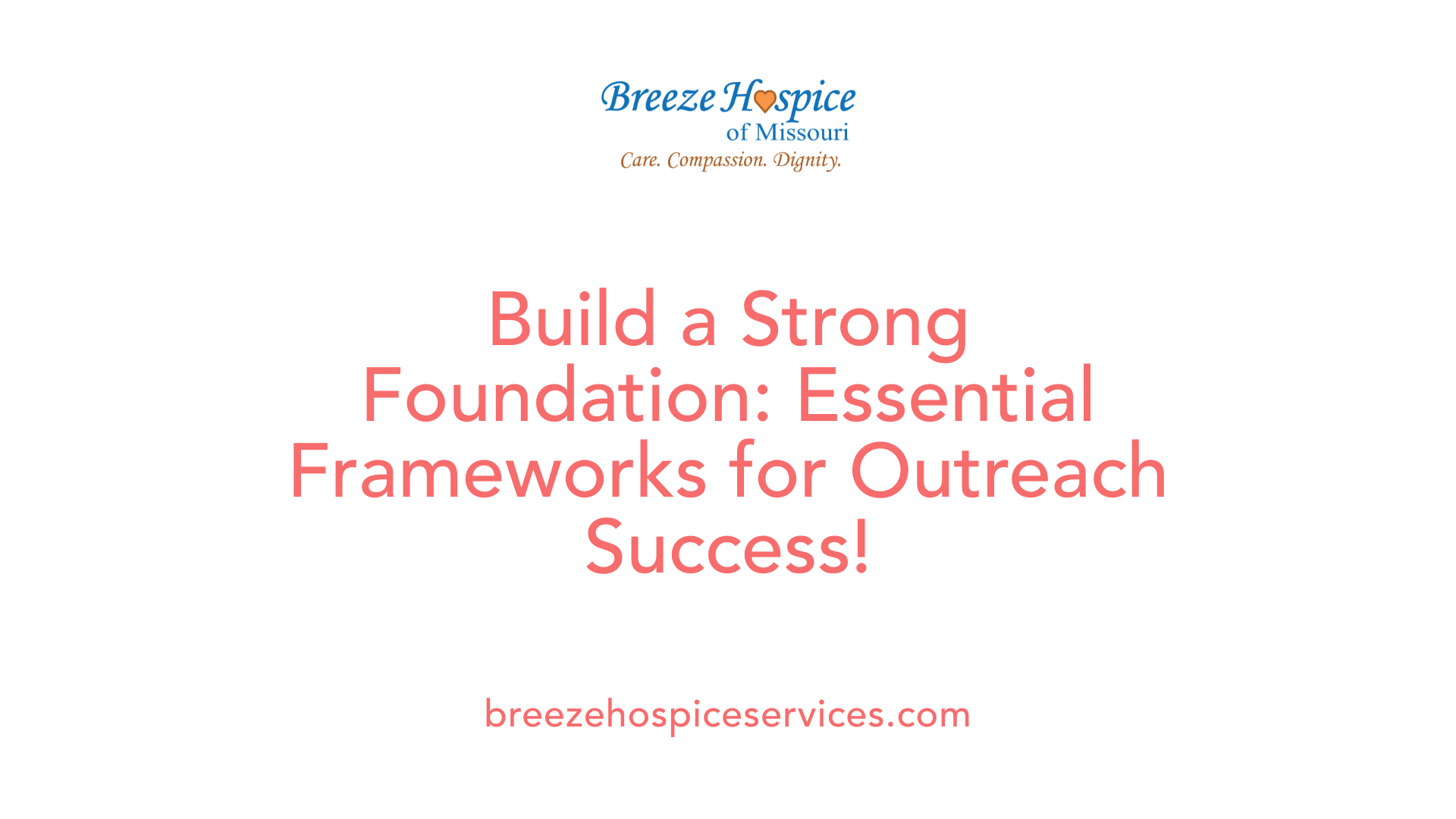Creating Hospice Care Outreach Programs
April 4, 2025
Strategies for Effective Hospice Outreach Initiatives

Understanding Hospice Care Outreach
Developing hospice care outreach programs is essential for connecting communities with necessary end-of-life care resources. Outreach programs enhance awareness of hospice services, promote the integration of palliative care within healthcare systems, and address barriers related to patients' perceptions. This narrative outlines the strategies, educational tools, and frameworks needed to establish impactful hospice outreach initiatives, focusing on community engagement, best practices, and sustainable program development.
Key Strategies for Developing Hospice Outreach Programs

What are the best practices for promoting hospice care?
To promote hospice care effectively, organizations should harness the power of digital storytelling by sharing impactful patient and family testimonials across their website and social media platforms. This approach not only humanizes the services offered but also builds trust within the community.
Optimizing the user experience on websites is crucial. They should be mobile-responsive and easy to navigate, enhancing engagement with potential clients. Focusing on local SEO strategies ensures that organizations appear in relevant searches, thereby increasing visibility for those seeking compassionate end-of-life care.
Engaging the community through social media interactions can raise awareness and provide vital connections with those who may benefit from hospice services. Organizing educational webinars is another effective method. These sessions can inform the community about the benefits of hospice care, demystifying misconceptions and explaining available services.
Furthermore, implementing data-driven marketing strategies can help organizations target their outreach effectively, allowing them to reach more individuals and families who require support during challenging times. This combination of storytelling, education, and strategic marketing can significantly impact the effectiveness of outreach programs.
Educational Resources and Tools for Hospice Outreach

Training Sessions for Enhanced Care
The University of North Dakota's Center for Rural Health (CRH) organizes training sessions focusing on palliative care. These sessions are aimed at building local palliative care teams in rural communities. By equipping healthcare providers with critical skills, these training programs enhance the quality of care delivered, ultimately improving patient outcomes.
Building Interdisciplinary Teams
CRH emphasizes the importance of forming interdisciplinary teams from community organizations. This collaborative effort improves palliative care services and enhances the overall effectiveness of outreach programs. By harnessing diverse skills and perspectives, these teams can better address the unique needs of their communities.
Palliative Care Provider Directory
To streamline access to palliative care, CRH offers a Palliative Care Provider Directory. This tool helps connect patients and families with available services, ensuring they receive the necessary support. By facilitating this connection, outreach efforts are strengthened, promoting a more comprehensive approach to palliative care throughout the region.
Frameworks for Successful Outreach Program Implementation

Community-Based Needs Assessments
Conducting community-based needs assessments is essential for developing effective palliative care outreach programs. These assessments engage patients, families, and community stakeholders to identify specific healthcare needs and preferences. This approach ensures that the programs align with the relevant challenges and expectations of the community. By understanding unique local issues, organizations can tailor their outreach messages effectively.
Mission and Vision Statements
A well-defined mission and vision statement is crucial for any palliative care program. The mission statement articulates the services offered and the patient population served, providing a clear direction for the program. Meanwhile, the vision statement expresses the overarching goals and aspirations of the organization. Together, these elements guide strategic planning and help the program navigate its development in alignment with community requirements.
Strategic Planning
Engaging in strategic planning is vital for articulated program development. This process should involve the leadership team and focus on defining the community's need for palliative care services. By outlining objectives, expected outcomes, and potential collaboration with other healthcare providers, organizations can create a robust framework that enhances care delivery. Additionally, regular assessments of outreach effectiveness through community feedback can help refine these strategies over time, ensuring continual improvement and responsiveness to changing needs.
| Framework Component | Description | Importance |
|---|---|---|
| Community-Based Needs Assessments | Engaging locals to identify specific health needs & preferences. | Tailors outreach to community challenges. |
| Mission and Vision Statements | Articulates services and overarching goals. | Provides direction & ensures alignment with community needs. |
| Strategic Planning | Involves leadership in defining objectives & collaboration. | Enhances program robustness and effectiveness. |
Engaging the Community in Hospice Outreach

Community Involvement
Community engagement plays a crucial role in hospice outreach initiatives. By involving local congregations or groups to host monthly drives for essential supplies, organizations can better address community needs. Programs like the Caring Closet, which assisted over 3,000 individuals last year, exemplify the benefits of community support in enhancing hospice care.
Public Presentations
Organizations often conduct free presentations on hospice, palliative care, and community resources. These talks, aimed at civic and faith groups, improve awareness of available services, ensuring that families are well-informed about their options during critical times. In-person educational outreach fosters deeper understanding among healthcare providers, helping clarify the benefits of palliative care.
Feedback Mechanisms
Regular assessment of outreach effectiveness is essential. Gathering feedback from community stakeholders helps align messaging with the needs of patients and families. This engagement empowers organizations to refine their strategies, ensuring that outreach efforts resonate and effectively communicate care options.
Evaluating and Sustaining Outreach Programs

What are the 7 Cs of care for terminally ill patients?
The 7 Cs of care for terminally ill patients encompass a holistic approach to palliative care:
- Communication: Engaging patients and families in open dialogue about preferences and needs.
- Coordination: Ensuring seamless transitions and collaboration among different healthcare providers.
- Continuity: Providing consistent support throughout the care journey, especially during critical phases.
- Control of Symptoms: Employing strategies to effectively manage both physical and emotional distress.
- Compassion: Demonstrating empathy and understanding towards patients and their families.
- Cultural Competence: Being sensitive to the diverse backgrounds and values of patients.
- Care in the Dying Phase: Offering specialized support to enhance dignity and comfort at the end of life.
How can stakeholder feedback improve outreach?
Feedback from community stakeholders is vital for refining outreach initiatives. By regularly gathering insights from patients, families, and healthcare providers, organizations can better tailor messaging and services. This assessment can help identify gaps and optimize program effectiveness, ensuring that the outreach aligns with the evolving needs of the community.
What financial strategies support palliative care outreach?
Developing robust financial strategies is essential for sustaining outreach programs. Key approaches include:
- Utilizing Reimbursement Methodologies: Exploring Medicaid payment options to support interdisciplinary care.
- Cost Estimates: Focusing on expected utilization rates and potential cost savings from improved care delivery.
- Partnerships and Sponsorships: Collaborating with local organizations to bolster financial support through community engagement activities.
By implementing these strategies, organizations can enhance the sustainability of their outreach efforts while addressing the financial aspects crucial for program implementation.
Conclusion: Building Sustainable Hospice Outreach Programs
Creating sustainable hospice care outreach programs requires a multifaceted approach that includes establishing educational resources, fostering community engagement, and developing strategic partnerships. Through clear frameworks and effective practices, organizations can not only enhance visibility and community trust but also ensure continuity and quality of care for patients and families in need. By continuously evaluating and adapting outreach efforts based on community feedback, hospice providers can sustain their initiatives and provide compassionate, effective end-of-life care.
References
- [PDF] Palliative Care Outreach Project- UND Center for Rural Health
- [PDF] Branding, Messaging, Outreach, and Marketing - NHPCO
- Seven Steps for Building a Community-Based Palliative Care ...
- Serving Our Community - Hospice of the Valley
- Hospice Led Palliative Care Toolkit
- [PDF] Community-Based Palliative Care Demonstration Model - NHPCO
- Hospice Foundation of America: Home



































































































